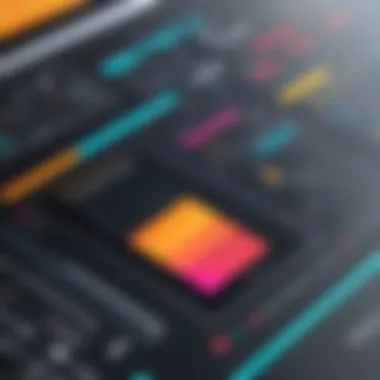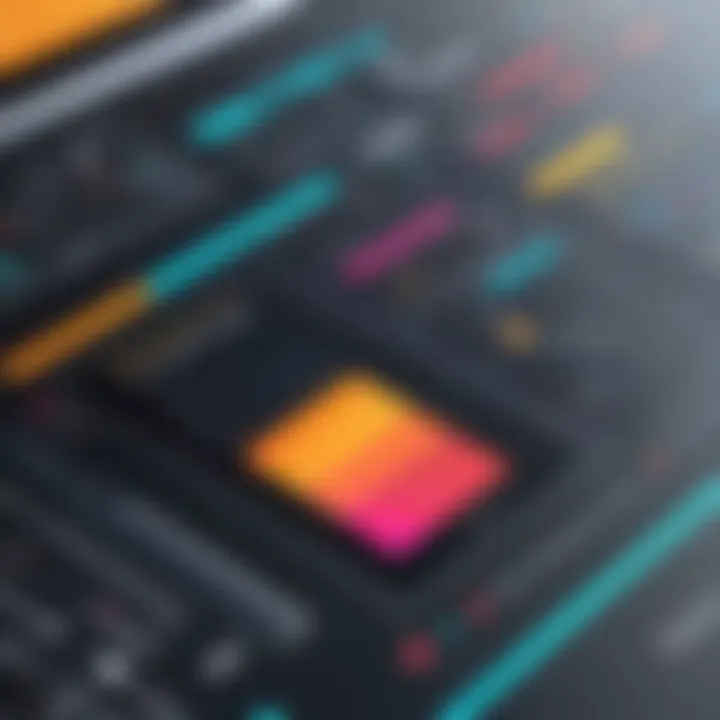Mastering Computer Instruction Recording Techniques


Intro
In a world increasingly driven by technology, effective communication is paramount. Learning to record instructions on a computer can streamline workflows, enhance clarity, and ensure accuracy in conveying information. This article explores the various approaches to recording instructions, including software tools, hardware setups, and best practices. Whether you are creating a tutorial or drafting user manuals, understanding how to record instructions efficiently is essential for tech-savvy individuals, gadget lovers, and early adopters alike.
Overview of the Technology
Recording instructions on a computer involves a range of technologies that cater to different needs. From audio recordings to screen captures, the right technology enhances the way we document and share information. The following sections will examine key specifications and unique selling points of various tools available in the market.
Key specifications
When considering tools for recording instructions, pay attention to:
- Audio Quality: High-fidelity audio ensures that verbal instructions are clear and intelligible. Look for tools that support a minimum of 44.1 kHz sampling rates.
- Video Resolution: If recording screen activity, opt for a resolution of at least 1080p to capture detailed visuals effectively.
- File Formats: Support for common formats like MP3 for audio and MP4 for video ensures compatibility across different platforms.
Unique selling points
Consider the following factors when selecting a recording tool:
- User Interface: Intuitive design can enhance usability, allowing users to navigate functions without a steep learning curve.
- Integration: Some tools integrate with project management software, making it easier to organize and share recordings.
- Editing Features: Built-in editing capabilities permit users to refine their recordings post-production, saving time and effort.
Design and Build Quality
Choosing the right tool can be as important as the technology itself. A good design and build quality can greatly impact user experience.
Material used
Tools made from durable, high-quality materials tend to last longer and resist wear. For example, lightweight aluminum or hard plastics can enhance portability while ensuring sturdiness.
Ergonomics and usability
Ergonomics play a vital role, especially in hardware components. Devices like microphones should be easy to position, and audio interfaces should allow for quick adjustments without hassle.
Intro to Recording Instructions
Recording instructions on a computer has become essential in our increasingly digital world. The ability to clearly convey information is critical for communication in both professional and personal environments. This article provides a framework for understanding how to effectively record instructions, ensuring that the audience can grasp technical details without unnecessary complications.
Relevance of Recording Instructions
Recording instructions is not only about saving time but also about enhancing clarity. In many cases, written instructions may not convey nuances necessary for understanding a particular process. Audio and video recording allow the instructor to demonstrate techniques in real-time. This can be especially beneficial in technical fields like programming, onboarding new employees, or training sessions, where visual cues can enhance comprehension. The integration of these methods leads to the reduction of miscommunication, fostering an environment where tasks are performed efficiently.
Overview of Available Tools
The process of recording instructions can be supported by various tools designed to fit different needs. Utilizing the proper tools can yield high-quality recordings that communicate instructions effectively. Generally, recording can be done using hardware such as microphones and cameras, or software applications that specialize in audio, video, and screen recording.
- Audio Recording Tools: Programs like Audacity allow the user to record clear audio while providing editing functionalities that enhance the sound quality.
- Video Recording Tools: Software such as Camtasia allows for sophisticated video solutions related to capturing tutorials, while also providing options for editing and adding transitions.
- Screen Recording Tools: OBS Studio is a favorite for many due to its flexibility in capturing different screen activities, making it useful for creating comprehensive guides.
These tools come together to create an integrated recording experience that can elevate the quality of the instructions delivered to the audience.
The right tools can drastically improve how information is recorded and shared, making them invaluable for anyone looking to enhance their instructional materials.
Understanding Different Recording Methods
Recording instructions on a computer can take various forms, and understanding these methods is vital for producing effective documentation. Each recording method serves distinct purposes and possesses unique advantages. Grasping which method to use can align with specific content delivery goals, audience preferences, and overall usability.
Additionally, the choice of recording method can significantly impact the clarity and accessibility of your instructions. For instance, audio recording is often more personal and easier to digest for the listener, while video recording can visually demonstrate processes, making it ideal for complex tasks. Screen recording stands out by allowing users to share real-time actions on their computer, ensuring precision in instruction.
Ultimately, knowing the different methods equips you, as a creator, to select the most effective way to communicate the information. This understanding drives quality in educational content and ensures both engagement and utility.
Audio Recording
Audio recording is a straightforward method for capturing verbal instructions. It serves many purposes, from narrated tutorials to personal messages. The benefits of audio recording include its simplicity and the speed at which it can be produced. Many users prefer audio because it allows them to provide instructions without the need for visual elements. Furthermore, this method is less resource-intensive, requiring minimal hardware and software.
To achieve clear audio quality, choosing the right microphone is essential. USB microphones like the Blue Yeti or Audio-Technica ATR2100x are popular choices. They provide ease of use and decent sound quality, making them suitable for various environments, whether professional or casual. Consideration of acoustics in your recording space can enhance sound quality. A quiet environment, free from echo and background noise, enables clearer instructions.
Video Recording
Video recording combines visual and audio elements, making it a powerful tool for instruction. It allows for detailed presentation of processes, which can be crucial for subjects requiring step-by-step guidance. For example, demonstrating software usage or showcasing physical tasks can be much more effective when the viewer can see every action.
When embarking on video recording, an ideal camera setup is required. Choosing equipment depends on your budget and quality needs. Entry-level webcams like the Logitech C920 are user-friendly and capture good quality video. On the other hand, more advanced options like DSLR or mirrorless cameras create higher-quality footage, but they may require more technical setup and understanding.
Screen Recording
Screen recording specifically targets the computer display, making it invaluable for tutorials and demonstrations. This method excels in environments where direct manipulation of software or applications is involved. Users can follow along, seeing exactly what the instructor sees, which fosters better understanding through visual engagement.


Popular tools for screen recording include OBS Studio and Camtasia, noted for their user-friendly interfaces and robust features. Such software often allows for integration of audio commentary, webcam overlay, and annotations, enhancing the instructional quality. Recording settings can be adjusted for resolution and frame rates to ensure the final product is clear and professional.
"Screen recording transforms static instructions into dynamic guides that reflect the user experience."
By understanding these recording methods—audio, video, and screen recording—you can tailor your approach to meet your specific instruction goals. Choosing the correct type not only enhances instructional quality but also aligns with user expectations and learning styles.
Choosing the Right Software
Selecting appropriate software for recording instructions is a pivotal step in ensuring clarity and precision. The right tool can significantly enhance the quality of your recordings and ease the entire process. This choice involves evaluating features, ease of use, and overall effectiveness in meeting your specific needs.
Features to Look For
When evaluating software options, certain features stand out as essential. Look for:
- User-friendly interface: Software should be intuitive, allowing users to navigate seamlessly.
- Multi-format support: The ability to export recordings in various formats ensures flexibility for sharing.
- Editing capabilities: Basic editing tools can help refine recordings, making them more polished and professional.
- Integration with other tools: Compatibility with other applications can enhance workflow efficiency.
- Customization options: Tailoring settings to suit personal requirements can enhance user experience.
Popular Software Options
Several popular software options cater to different recording needs. Each of these has unique features that appeal to various users.
Audacity
Audacity is well-regarded for its audio recording capabilities. It is an open-source program, meaning it is free to use and extensively supported by a community of users.
The primary characteristic of Audacity is its robust audio editing functions. This makes it a beneficial choice for those needing quality audio instructions. Its unique feature lies in its ability to handle multiple tracks and provide powerful editing tools like effects and equalization beyond basic functionalities.
Nevertheless, an advantage is its extensive support community, while a disadvantage may be its steeper learning curve for beginners unfamiliar with audio software.
Camtasia
Camtasia is known for its comprehensive screen recording and video editing capabilities. It is particularly useful for those looking to produce detailed instructional videos.
The key characteristic of Camtasia is its screen capture features paired with a user-friendly editor. This allows users to create polished videos effortlessly. Its unique feature is the in-built quiz and interactivity capabilities, enabling creators to engage their audience.
While it offers a user-friendly experience, its price point can be a notable disadvantage for users on tight budgets.
OBS Studio
OBS Studio is excellent for real-time video recording and live streaming. It stands out with its flexibility and free availability, making it accessible to a wide range of users.
What makes OBS Studio particularly compelling is its open-source nature, allowing for extensive customization through plugins. This opens opportunities for power users to enhance functionality.
On the downside, its complex setup can pose challenges for new users, which can be a barrier to entry for those unfamiliar with technical setups.
ScreenFlow
ScreenFlow is particularly effective for Mac users seeking high-quality screen recording solutions. Its primary strength lies in its intuitive editing tools.
ScreenFlow’s unique feature is its ability to record your computer screen along with audio from any external microphone or camera. This capability fosters a seamless integration of visuals and narration.
However, a disadvantage includes its exclusivity to Mac systems, leaving Windows users with fewer options. Moreover, the price can be a limiting factor for those early in their recording endeavors.
Choosing the right software ultimately depends on your specific needs, preferences, and budget. The options discussed are influential in shaping how effectively you document instructions.
Exploring Hardware Solutions
When recording instructions on a computer, the hardware you use can significantly impact the clarity and effectiveness of your recordings. Choosing suitable hardware ensures high-quality audio and video capture, which is essential for clear communication. In this section, we will explore essential hardware components, focusing on microphones and cameras. Each of these elements plays a critical role in how well the final instruction is received by your audience.
Microphones for Clear Audio
Types of Microphones
There are several types of microphones available for recording audio. Understanding these can help in selecting the right option for your needs.
- Dynamic Microphones: They are robust and can handle high sound pressure, making them ideal for loud environments. Their durability makes them long-lasting.
- Condenser Microphones: These are generally more sensitive and capture a wider frequency range. They are preferred for vocal recordings and intricate sounds.
The key characteristic of dynamic microphones is their resistance to background noise. This makes them a popular choice for voice instructions in non-ideal settings. On the other hand, condenser microphones may pick up more detail in quieter environments but could also capture unwanted noise.
Budget Options
Budget options are particularly relevant for individuals or small businesses attempting to minimize expenses while still achieving decent recording quality. Mic brands like Fifine or Behringer provide affordable solutions without compromising too much on performance.
Choosing budget microphones can still yield clear audio, albeit with potential limitations on durability and sensitivity when compared to higher-end models. They might not suit professional settings where the highest audio fidelity is necessary, but for casual recording, they perform well.
Professional Choices


Professional microphones, like the Shure SM7B or the Audio-Technica AT2020, elevates audio quality significantly. These options are often used by podcasters and professional content creators because they ensure clear and rich sound reproduction.
The unique feature of these microphones is their ability to capture nuances in sound that budget options may miss. This can make a substantial difference in how instructions are conveyed, particularly when nuance is important. However, the drawback is their higher price, which may not be justifiable for everyone, especially for casual users.
Cameras for Video Recording
Webcams
Webcams are an accessible choice for most users. They are easy to set up and use, making them suitable for casual recordings, such as video instructions and webinars.
Many modern webcams offer decent resolution and can record in HD. However, the quality may not match that of more advanced camera types. They are ideal for straightforward tasks but could fall short in low-light situations.
DSLRs
Digital Single-Lens Reflex cameras, or DSLRs, significantly enhance video quality, offering features such as interchangeable lenses and superior performance in various lighting conditions.
The key benefit of DSLRs is their ability to produce cinematic quality videos. This is especially useful for instructional content that requires visual detail. The initial learning curve, however, can be steep, requiring more familiarity with camera settings.
Action Cameras
Action cameras, like the GoPro series, are designed for versatility. These compact devices can capture high-quality video even in challenging situations, making them suitable for recording dynamic instructions.
Their unique feature is the ability to withstand harsh conditions and be mounted in various locations. However, they may not have the same audio capabilities as microphones, often requiring external recording solutions for the best results.
By selecting appropriate hardware, you can improve the clarity and overall quality of your instructional recordings. The right microphone and camera combination can make a significant difference. Choose options based on your specific recording needs, budget, and desired quality.
Best Practices for Effective Recording
Recording instructions effectively is crucial to ensure clarity and engagement. The quality of recorded content can directly influence how well the audience understands and retains information. Hence, there are specific best practices to follow that enhance the overall recording experience. These practices will lead to more professional and polished results, which is essential for tech-savvy individuals and early adopters of technology looking to communicate their ideas effectively.
Preparing Your Environment
Creating the right environment is a fundamental aspect of effective recording. Background noise, poor lighting, and distractions can significantly impair the quality of your output. Consider the following elements:
- Quiet Space: Choose a location that is devoid of distracting sounds. You may use soundproofing materials like acoustic panels to minimize echo.
- Lighting: Ensure that the area is well-lit. For video recordings, natural light is beneficial. If using artificial light, position it to avoid shadows on your face.
- Arrangement: Keep equipment and materials organized to prevent interruptions during recording. A clean workspace can improve your focus and performance.
By taking these steps, the overall production quality increases, making instructions clearer and more authoritative.
Scripting Your Instructions
A script acts as a roadmap during your recording sessions. It helps maintain structure and allows you to articulate your thoughts clearly. Here are key points to consider when writing a script:
- Outline Key Points: Start with an overview of the major topics you want to cover. This serves as a reference guide during recording.
- Use Simple Language: Ensure that the language you choose is straightforward. Avoid jargon unless necessary; explain complex terms if you include them.
- Practice Delivery: Before recording, practice reading your script out loud. This will help you get comfortable with the material and adjust the flow to sound more natural.
Creating a well-thought-out script can prevent you from fumbling for words and helps your audience follow along easily.
Clarity and Conciseness
The power of simplicity in communication should not be underestimated. It is crucial to present your instructions clearly and concisely. Here’s how:
- Focus on Key Ideas: Only include information that supports your main points. Redundant information can overwhelm your audience.
- Use Visual Aids: When applicable, integrate visuals like slides or graphics to complement your verbal instructions. This multi-sensory approach reinforces learning.
- Pause for Emphasis: Use pauses effectively to highlight significant information. It gives your audience time to absorb crucial points and reflects confident speaking.
Editing and Post-Production Workflow
Editing and post-production are critical components when recording instructions on a computer. The purpose of this phase is to enhance the quality of the recorded content, ensuring that the final output is clear, succinct, and meets the intended goals. Editing allows the creator to sift through raw recordings, removing unnecessary segments while enhancing the clarity of critical instructions. Post-production further involves polishing the content to improve its appeal and effectiveness.
This workflow is not simply an afterthought; it plays a vital role in how the audience receives and understands the instructions. The benefits of a structured editing and post-production approach include reducing the cognitive load on viewers, enhancing user engagement, and conveying professionalism. A well-edited piece fosters trust with the audience, making them more likely to follow the instructions accurately.
Choosing Editing Software
Selecting the right editing software is the first step in streamlining your workflow. Powerful and user-friendly tools can significantly reduce the time spent on edits while improving overall quality. Here are some factors to keep in mind when selecting software:
- Functionality: Ensure the software supports features you need, such as multi-track editing, annotations, and effects.
- Ease of Use: The interface should be intuitive, especially for those new to editing.
- Compatibility: Check if it works well with your operating system and supports the format of your recordings.
Popular choices include Adobe Premiere Pro, known for extensive features, and Final Cut Pro for Apple users, offering high-quality video outputs. For audio editing, Audacity serves as a great free option that provides robust functionalities.
Basic Editing Techniques
Once you have chosen the editing software, familiarize yourself with basic editing techniques that can elevate your recording:
- Trimming Clips: Remove unnecessary sections at the beginning or end. This helps in making the content more focused and efficient.
- Adding Transitions: Smooth transitions between clips can enhance flow and keep the audience engaged.
- Incorporating Text and Graphics: Use text overlays for titles, key points, or instructions. Graphics like arrows or highlights can further clarify complex instructions.
- Balancing Audio Levels: Ensure consistent audio levels throughout the recording. Use tools within the software to adjust volume and eliminate background noise.
"Effective editing transforms ordinary recordings into captivating instructional content that resonates with audiences."
In summary, a robust editing and post-production workflow is essential for producing high-quality instructions on a computer. It not only improves clarity and engagement but also enhances the overall learning experience.


Storing and Sharing Recorded Instructions
Storing and sharing recorded instructions are critical components in the process of effective communication. Once you successfully capture your audio, video, or screen recordings, it is essential to have a systematic approach for managing these files. This ensures that your instructions remain accessible and can be easily disseminated to your audience.
The ability to store recorded instructions efficiently facilitates organization and retrieval. Without a proper storage solution, valuable content may become lost or hard to find. Additionally, sharing recorded instructions with the right audience enhances learning and supports collaboration. Thus, understanding storage solutions and sharing platforms is key to maximizing the utility of recorded content.
Cloud Storage Solutions
Cloud storage solutions provide a versatile way to save and access recorded instructions from anywhere. Services like Google Drive, Dropbox, and OneDrive offer ample storage along with features that promote easy sharing and collaboration.
- Accessibility: Cloud storage allows users to access files from various devices, making instructions readily available whether on a desktop, tablet, or smartphone.
- Collaboration: Many cloud services enable multiple users to collaborate on files, allowing for feedback and updates in real-time.
- Backup and Recovery: Storing recordings in the cloud minimizes the risk of data loss due to hardware failure.
Using these solutions lends a layer of security to your recordings, while also simplifying the process of sharing with intended recipients.
Sharing Platforms
Sharing platforms are vital for disseminating your recorded instructions effectively. They can reach individual viewers, groups, or a wider audience.
YouTube
YouTube is a prominent platform for sharing video content. Its vast audience base amplifies the reach of your instructional recordings. One key characteristic of YouTube is its user-friendly interface, allowing creators to upload videos without extensive technical knowledge. Moreover, YouTube includes search capabilities, making your recordings more discoverable.
- Benefits: The platform offers built-in analytics for viewer engagement, helping you assess the effectiveness of your content.
- Challenges: It’s important to note that YouTube has ads that may distract viewers from the material.
Vimeo
Vimeo caters to professional creators, focusing on high-quality videos. It provides ad-free environments, which is a major advantage for businesses concerned with maintaining viewer attention. The aesthetic quality of content on Vimeo often appeals to the tech-savvy audience.
- Benefits: Vimeo supports customizable privacy settings, allowing control over who sees your videos.
- Challenges: Generally, Vimeo offers limited free storage, requiring users to invest in paid plans for larger content needs.
Internal Networks
Internal networks, like Intranet systems, offer organizations a private way to store and share content. This is especially beneficial when sharing sensitive information or internal training materials. The key characteristic here is restricted access, ensuring that only authorized personnel can view the recordings.
- Benefits: Security is a significant advantage of using internal networks. It reduces the chances of data breaches.
- Challenges: Internal networks may limit accessibility for remote employees, especially if not integrated with mobile access.
Storing and sharing recorded instructions effectively can enhance knowledge transfer and improve team collaboration.
Common Mistakes to Avoid
Recording instructions can seem simple, but there are several common pitfalls that can undermine the effectiveness of the communication. Avoiding these mistakes is crucial to ensure clarity and achieve the intended purpose. Without addressing these issues, even well-structured content may fail to resonate with the audience or, worse, lead to misunderstandings. It’s worth taking the time to identify and correct these issues before finalizing any recording.
Neglecting Audio Quality
Audio quality is a cornerstone of effective instruction recording. Text can convey precise information, yet audio relies heavily on clarity and fidelity. When the audio is poor, the listener may struggle to grasp the message. This often occurs due to inadequate microphones or improper recording environments. To enhance audio quality, investing in a good microphone is essential. USB microphones like the Blue Yeti or the Audio-Technica AT2020 are popular for their sound quality and ease of use.
Acoustic treatment in the recording space cannot be overlooked. Background noise can significantly hinder audio clarity. A quiet environment or the use of soundproofing techniques can help minimize distractions. Simple steps like turning off unnecessary electronics, silencing phones, and recording during quieter times can make a difference. Additionally, monitoring audio levels during recording is key. Too low or too high can create issues in post-production.
In short, neglecting audio quality not only detracts from the message but also reflects poorly on the professionalism of the content.
Overloading with Information
Another mistake to avoid is overloading content with excessive information. While it may seem beneficial to pack as much detail into the instruction as possible, this can lead to confusion. People may find it challenging to follow instructions if they are presented with too many concepts or steps at once. Effective instruction should focus on clarity over quantity.
To combat information overload, it is important to segment content into digestible portions. Using bullet points or numbered lists facilitates better comprehension.
For example, instead of explaining a complex process all at once:
- Break the process into stage.
- Provide specific instructions for each step.
- Ensure that each part is easily understandable before moving on.
This allows the audience to absorb one piece at a time and return for clarification if needed. Also, engaging visuals during video recordings can simplify complex concepts, enhancing understanding.
Remember, the primary goal of recording instructions is clear communication. Keeping content streamlined and focused is fundamental to achieving that aim.
Finale
In the realm of digital communication, the act of recording instructions has gained paramount significance. This article emphasizes not only the methodologies and tools associated with the recording process but also how essential clear communication is in both professional and personal pursuits.
Summary of Key Points
Throughout our exploration, we have delved into various methods of recording instructions—be it through audio, video, or screen recording. Each method possesses its unique applications, catering to different needs. Choosing the right software and hardware plays a vital role in achieving the desired clarity and effectiveness. Best practices such as preparing your environment, scripting your instructions, and ensuring clarity have been underscored as crucial elements for successful recording. Moreover, editing and post-production techniques contribute substantially to the overall quality of the instruction material, ensuring it appeals to the intended audience. Lastly, storing and sharing recorded instructions using modern platforms allows for wide accessibility and collaboration.
Key points include:
- Various recording methods: audio, video, screen.
- Importance of selecting appropriate software and hardware.
- Best practices for effective instruction delivery.
- Post-production workflow elevates quality.
- Cloud storage and sharing tools facilitate collaboration.
Future Outlook
Looking forward, the landscape of recording instructions is poised for further evolution. The increasing integration of artificial intelligence and machine learning technologies may streamline the recording process significantly. Innovations might lead to automated transcription, enhancing accessibility for diverse audiences. Additionally, as virtual and augmented reality continue to mature, we may see new dimensions in how instructions are recorded and experienced.
Furthermore, the collaboration capabilities provided by online platforms will likely become the standard by which instructions are shared and interacted with. This ensures not only clarity but also fosters community engagement. The future of instructional recording holds the promise of even more intuitive, interactive, and user-friendly experiences that respond to evolving technological demands.







